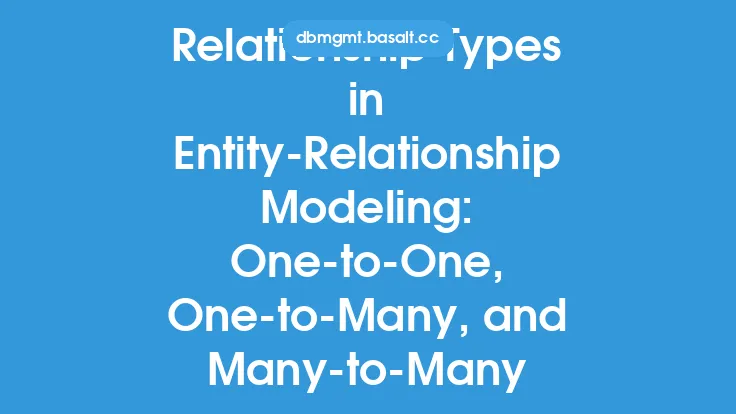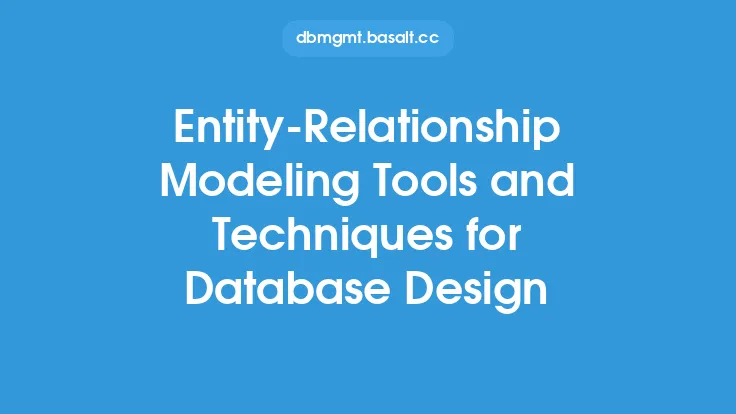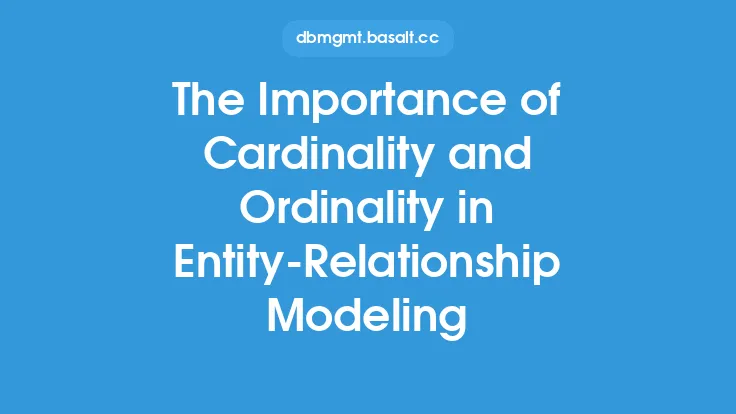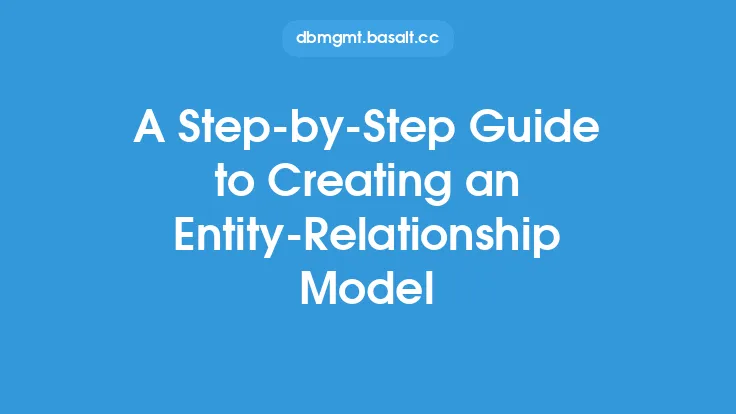Entity-Relationship modeling is a fundamental technique used in the field of data modeling to represent the structure and relationships of data in a database. It provides a visual representation of the data, making it easier to understand and communicate the requirements of the database to stakeholders. This technique was first introduced by Peter Chen in 1976 and has since become a widely accepted standard for data modeling.
Introduction to Entity-Relationship Modeling
Entity-Relationship modeling is based on the concept of entities, attributes, and relationships. An entity is a thing or concept that has independent existence, such as a customer, order, or product. An attribute is a characteristic or property of an entity, such as a customer's name or address. A relationship is a connection between two or more entities, such as a customer placing an order. The Entity-Relationship model represents these concepts using a diagram, which consists of entities, attributes, and relationships.
Components of an Entity-Relationship Model
An Entity-Relationship model consists of three main components: entities, attributes, and relationships. Entities are represented as rectangles, attributes are represented as columns or fields within the entity rectangle, and relationships are represented as lines connecting the entities. There are three types of relationships: one-to-one, one-to-many, and many-to-many. A one-to-one relationship exists when one entity is related to only one other entity, such as a customer having only one address. A one-to-many relationship exists when one entity is related to multiple other entities, such as a customer having multiple orders. A many-to-many relationship exists when multiple entities are related to multiple other entities, such as a customer having multiple orders and an order being related to multiple customers.
Types of Entities
There are two types of entities: strong entities and weak entities. A strong entity is an entity that has a unique identifier, such as a customer ID or order ID. A weak entity is an entity that does not have a unique identifier and relies on another entity for its existence, such as an order item relying on an order for its existence. Strong entities are represented as rectangles with a thick border, while weak entities are represented as rectangles with a dashed border.
Types of Attributes
There are several types of attributes, including simple attributes, composite attributes, and multivalued attributes. Simple attributes are single values, such as a customer's name or address. Composite attributes are made up of multiple simple attributes, such as a customer's full name being composed of first and last names. Multivalued attributes are attributes that have multiple values, such as a customer having multiple phone numbers.
Types of Relationships
There are several types of relationships, including identifying relationships and non-identifying relationships. An identifying relationship is a relationship where the child entity relies on the parent entity for its existence, such as an order item relying on an order for its existence. A non-identifying relationship is a relationship where the child entity does not rely on the parent entity for its existence, such as a customer being related to an order. Identifying relationships are represented as lines with a solid arrowhead, while non-identifying relationships are represented as lines with a dashed arrowhead.
Benefits of Entity-Relationship Modeling
Entity-Relationship modeling provides several benefits, including improved communication, increased data integrity, and enhanced data sharing. It provides a common language and notation for data modelers, stakeholders, and developers to communicate and understand the requirements of the database. It also helps to ensure data integrity by identifying relationships and constraints between entities, and it enables data sharing by providing a standardized representation of the data.
Best Practices for Entity-Relationship Modeling
There are several best practices for Entity-Relationship modeling, including keeping the model simple and focused, using meaningful names and definitions, and avoiding redundancy and ambiguity. The model should be simple and easy to understand, with clear and concise names and definitions for entities, attributes, and relationships. Redundancy and ambiguity should be avoided by ensuring that each entity, attribute, and relationship has a unique and well-defined purpose.
Tools and Techniques for Entity-Relationship Modeling
There are several tools and techniques available for Entity-Relationship modeling, including data modeling software, entity-relationship diagramming tools, and data modeling methodologies. Data modeling software, such as Entity-Relationship Diagram (ERD) tools, provides a graphical interface for creating and editing Entity-Relationship models. Entity-relationship diagramming tools, such as drawing tools, provide a simple and intuitive way to create Entity-Relationship diagrams. Data modeling methodologies, such as the Entity-Relationship modeling methodology, provide a structured approach to data modeling and Entity-Relationship modeling.
Common Challenges and Pitfalls
There are several common challenges and pitfalls to watch out for when using Entity-Relationship modeling, including data redundancy, data inconsistency, and data complexity. Data redundancy occurs when the same data is stored in multiple places, leading to inconsistencies and errors. Data inconsistency occurs when the data is not consistent across the database, leading to errors and inaccuracies. Data complexity occurs when the data model is too complex, leading to difficulties in understanding and maintaining the database.
Conclusion
Entity-Relationship modeling is a fundamental technique used in data modeling to represent the structure and relationships of data in a database. It provides a visual representation of the data, making it easier to understand and communicate the requirements of the database to stakeholders. By following best practices, using the right tools and techniques, and avoiding common challenges and pitfalls, data modelers can create effective and efficient Entity-Relationship models that support the needs of the organization.





